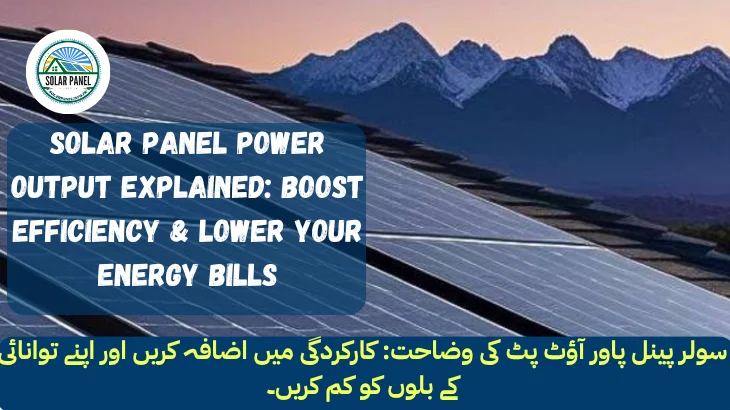Solar Panel Power Output Explained: Boost Efficiency & Lower Your Energy Bills
Solar energy is becoming a popular choice for homeowners and businesses to lower electricity costs and promote sustainability. This guide covers solar panel power generation, factors influencing efficiency, and tips to enhance solar installations for cost savings. A key question is the power output of solar panels, which is vital for those considering solar energy. To estimate energy needs, using a solar calculator is recommended. The article discusses potential power generation, relevant elements affecting it, and the significance of understanding these factors.
Read more: High-efficiency solar panels in Pakistan

شمسی توانائی گھر کے مالکان اور کاروبار کے لیے بجلی کی لاگت کو کم کرنے اور پائیداری کو فروغ دینے کے لیے ایک مقبول انتخاب بن رہی ہے۔ اس گائیڈ میں سولر پینل سے بجلی کی پیداوار، کارکردگی کو متاثر کرنے والے عوامل، اور لاگت کی بچت کے لیے شمسی تنصیبات کو بڑھانے کے لیے تجاویز شامل ہیں۔ ایک اہم سوال سولر پینلز کی پاور آؤٹ پٹ ہے، جو شمسی توانائی پر غور کرنے والوں کے لیے بہت ضروری ہے۔ توانائی کی ضروریات کا اندازہ لگانے کے لیے، شمسی کیلکولیٹر استعمال کرنے کی سفارش کی جاتی ہے۔ مضمون میں بجلی کی ممکنہ پیداوار، اس پر اثر انداز ہونے والے متعلقہ عناصر، اور ان عوامل کو سمجھنے کی اہمیت پر بحث کی گئی ہے۔
Understanding Solar Panel Output
The power output of a solar panel indicates the quantity of electricity it can produce under optimal conditions. This output is usually expressed in watts (W) or kilowatts (kW).
Solar panels receive their ratings based on Standard Test Conditions (STC), which comprise:
- Irradiance: 1,000 watts per square meter
- Cell Temperature: 25°C (77°F)
- Air Mass: 1.5 (typical angle of sunlight)
As an illustration, a solar panel with a rating of 400W under STC should ideally produce 400 watts of power per hour when conditions are perfect.\
Solar Panel Power Real Production
The power produced by solar panels is measured in watts (W). A typical residential solar panel produces between 250 to 400 watts, with a 500-watt panel serving as an example. Under ideal conditions, a 500-watt panel can generate 500 watts per hour in direct sunlight. If exposed to sunlight for 5 hours a day, it can produce about 2500 watt-hours (Wh), which equals 2.5 kilowatt-hours (kWh).
| Hours of Sunlight per Day | Power Generated (Wh) | Power Generated (kWh) |
| 1 | 500 | 0.5 |
| 2 | 1000 | 1 |
| 3 | 1500 | 1.5 |
| 4 | 2000 | 2 |
| 5 | 2500 | 2.5 |
| 6 | 3000 | 3 |
| 7 | 3500 | 3.5 |
| 8 | 4000 | 4 |
| 9 | 4500 | 4.5 |
| 10 | 5000 | 5 |
Average Power Output of a Solar Panel
The typical residential solar panel produces between 250 to 450 watts of power per hour.
| Panel Type | Output (W) | Daily Output (kWh)* | Monthly Output (kWh)* |
| 250W | 0.25 kWh | 1.25 – 2.0 kWh | 37.5 – 60 kWh |
| 400W | 0.4 kWh | 2.0 – 3.2 kWh | 60 – 96 kWh |
Factors Influencing Solar Panel Efficiency
Understanding solar panel efficiency involves several key factors:
Sunlight Exposure
Direct sunlight is essential for maximum power output; shading leads to significant efficiency drops.
Panel Orientation and Angle
Ideally, panels should face south in the Northern Hemisphere and be angled according to latitude and season to optimize sunlight capture.
Temperature Effects
High temperatures can decrease efficiency as they lower voltage output, with panels tested for optimal performance at 25°C (77°F).
Quality of Solar Cells
The efficiency varies with the type of solar cells; monocrystalline cells are typically more efficient than polycrystalline.
Inverter Efficiency
High-quality inverters minimize energy loss during the conversion of DC to AC, enhancing overall efficiency.
Maintenance and Cleanliness
Regular cleaning and maintenance are necessary to prevent dirt and debris from blocking sunlight.
Weather Conditions
Cloudy weather, rain, and snow can reduce sunlight exposure and thus decrease energy output from the panels.
Maximizing Solar Panel Efficiency
Here are some effective strategies to maximize your solar panel system’s performance:
Enhance Installation
- Collaborate with a qualified installer to identify the optimal roof angle and orientation.
- Avoid areas that receive shade and opt for high-efficiency panels.
Maintain Panel Cleanliness
- Debris such as dust, leaves, and bird droppings can obstruct sunlight.
- Clean your panels every 6 to 12 months or consider installing self-cleaning options.
Utilize a High-Quality Inverter
- Make sure to have a reliable inverter to convert solar DC electricity into usable AC.
- Think about using microinverters for improved performance in shaded or complex roofing situations.
Track Performance
- Employ solar monitoring applications to keep tabs on both daily and monthly energy production.
- Quickly address any declines in performance through proper maintenance.
Incorporate a Solar Battery
- Store surplus energy for nighttime use or during outages.
- This helps minimize grid dependency and maximize savings.
Saving on Energy Costs with Solar
Solar energy can significantly help in reducing your energy expenses in several ways:
- Offsetting Grid Usage: By utilizing solar energy, you can decrease the amount of electricity you need to draw from the grid.
- Net Metering: With net metering, you have the opportunity to sell any excess electricity you generate back to your utility provider, allowing you to earn credits on your energy bill.
- Long-Term Return on Investment: Typically, solar systems can pay for themselves within a span of 5 to 8 years. After this period, they can provide free electricity for an additional 15 to 20 years, enhancing your overall savings.
The Importance of Knowing Power Output
Grasping the amount of energy a solar panel can generate is crucial for figuring out how many panels are necessary to satisfy your energy requirements. For instance, if your household consumes 30 kWh of electricity daily, and you have 500-watt panels that receive 5 hours of sunlight each day, you would require approximately 12 panels to fulfill your daily energy consumption.
Advantages of Using Solar Panels
- Renewable Energy Source: Solar power is categorized as a renewable resource, ensuring its availability as long as the sun continues to shine.
- Reduced Electricity Bills: Once installed, solar panels can significantly lower your electricity expenses, resulting in substantial savings over time.
- Environmental Benefits: Utilizing solar energy is environmentally friendly, as it produces no harmful emissions, contributing to a cleaner and healthier planet.
- Low Maintenance Costs: Solar panels are designed for minimal maintenance. Regular cleaning and occasional inspections are typically sufficient to maintain their efficiency and performance.
Real-Life Examples
- Residential Use: Homeowners install solar panels to lower electricity bills; for example, a California family with a 6 kW system produces about 900 kWh monthly, meeting most of their energy needs.
Read more: 6kW Solar Systems Price in Pakistan
- Schools and Universities: Institutions like a New Jersey high school utilize solar energy, covering 30% of their electricity needs and saving thousands annually.
- Businesses: Companies, such as a Texas warehouse, use solar panels to decrease operating costs by generating enough power for their daytime operations, reducing dependence on the grid.
Conclusion
Grasping the mechanics behind solar panel energy output is essential for making informed choices about energy. By understanding the elements that influence performance and applying methods to enhance efficiency, you can greatly lower your energy expenses and boost the long-term worth of your solar investment. Whether you are a residential user or a commercial entity, solar energy provides a dependable, environmentally friendly, and economical option for your electricity requirements.
توانائی کے بارے میں باخبر انتخاب کرنے کے لیے شمسی پینل کی توانائی کی پیداوار کے پیچھے میکینکس کو سمجھنا ضروری ہے۔ کارکردگی کو متاثر کرنے والے عناصر کو سمجھ کر اور کارکردگی کو بڑھانے کے طریقوں کو لاگو کرنے سے، آپ اپنے توانائی کے اخراجات کو بہت کم کر سکتے ہیں اور اپنی شمسی سرمایہ کاری کی طویل مدتی مالیت کو بڑھا سکتے ہیں۔ چاہے آپ رہائشی صارف ہوں یا تجارتی ادارہ، شمسی توانائی آپ کی بجلی کی ضروریات کے لیے ایک قابل اعتماد، ماحول دوست اور اقتصادی آپشن فراہم کرتی ہے۔
FAQ’s
How much electricity can one solar panel produce in a day?
A typical solar panel (300–400W) can generate between 1.5 and 3.2 kWh per day, depending on the amount of sunlight received.
Can solar panels work during cloudy or rainy days?
Yes, panels still generate electricity, but at a reduced rate.
How many solar panels do I need to power my home?
Energy needs and sunlight availability determine solar panel requirements. A typical home using 30 kWh per day may require 10 to 14 panels, each rated between 400 and 500 watts.


